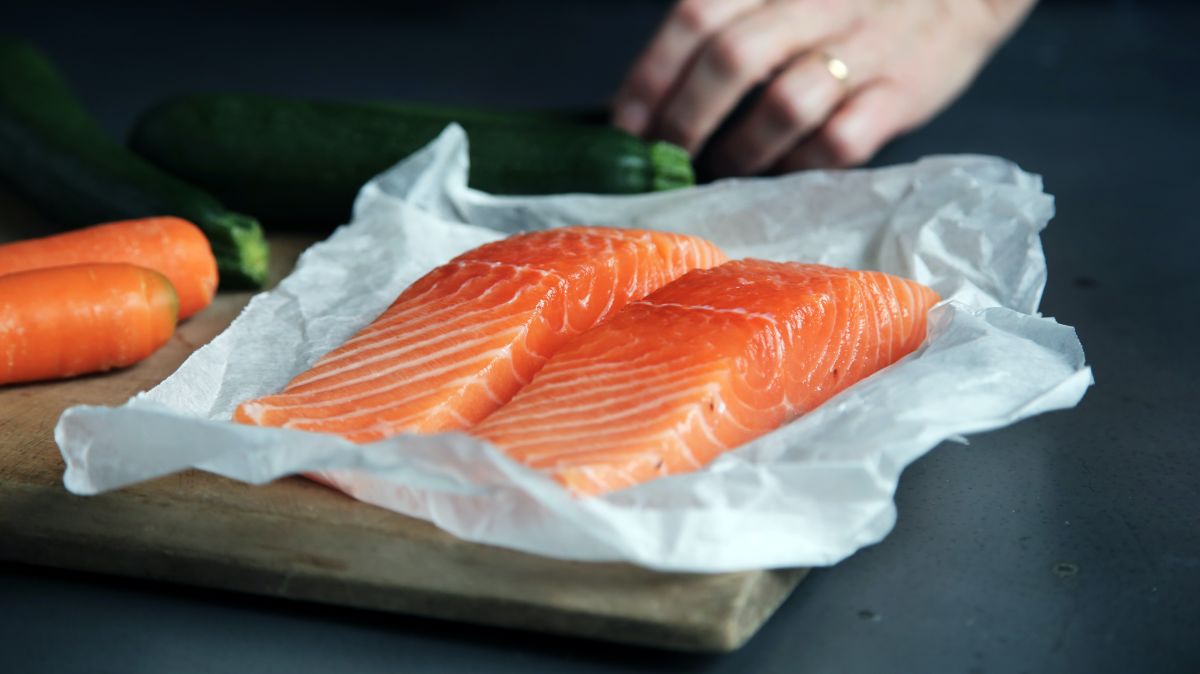Seafood

Seafood can be a valuable source of nutrition during pregnancy; therefore, pregnant women should not avoid seafood during pregnancy. Women are simply advised to understand certain considerations and take cautionary steps to avoid a potential accumulation of mercury in the body.
The build up of mercury in the blood appears to be the main pathway to adverse pregnancy outcomes. One meal of seafood containing a higher amount of mercury is not likely to cause harm, but regular consumption of certain species of fish could cause developmental complications.
However, international guidelines regarding the mercury content of certain species varies greatly, as the same species can contain different levels of mercury depending on what region of the world the species was sourced. Therefore, mercury content of fish is estimated, at best.
As a result, women are advised to eat seafood regularly during pregnancy, but only two to three servings/twelve ounces per week of seafood species known to contain lower amounts of mercury. To date, this is the best recommendation in which women can still obtain vital nutrients offered by seafood, but avoid possible mercury accumulation during pregnancy.
Background
Seafood is an important source of nutrition for the general population, including pregnant women. However, guidelines regarding seafood consumption during pregnancy can be very confusing.
Women are not advised to avoid fish – they are advised to avoid fish that are known to have a higher mercury content; they are also advised, on average, to consume no more than three servings of fish per week to prevent a possible cumulative consumption of mercury.
Well-publicized warnings among various international health regulatory agencies regarding fish consumption during pregnancy has led many women to avoid fish intake all together.
What is known:
Fish is a vital source of omega 3-fatty acids and other nutrients.
High amounts of certain fish can lead to a potential build-up of methylmercury, a neurotoxin.
Therefore:
Women should avoid – all together – predatory fish species that are known to have higher amounts of methylmercury.
Women should limit, but not avoid, consumption of other fish species to about three servings per week.
This guidance allows women to obtain beneficial nutrients during pregnancy while avoiding risks associated with methylmercury consumption and adverse pregnancy outcomes.

However, the guidelines above get significantly more nuanced and confusing regarding specific fish types and recommendations by various international health organizations. This is due to the highly variable mercury content of different species of seafood based on the region of the world in which the seafood originated.
Benefits
Strong evidence links fish consumption during pregnancy with positive neurological and developmental outcomes on the fetus:
A study published in June 2021 found that maternal fish intake during pregnancy could help lower the risk of wheeze, eczema and food allergy in children.
The nutritional benefits of seafood intake in pregnancy are immense; the concern lies with the amount of mercury that may also be consumed with high amounts of seafood.
Mercury
Mercury is a metal that occurs naturally in the environment, accumulating in the aquatic food chain as methylmercury (mercury).
Mercury can also be in the form of a colorless, odorless, poisonous vapor in the air, released when something containing it is spilled, breaks, or purposefully released (industrial processes); this vapor falls back to the ground and builds up in oceans, lakes, rivers, and streams.

Exposure can occur through touch, inhalation, or consumption. Moderate exposure adverse effects are subtle, and may include deficits to neurological function, the cardiovascular system, and immune function.
High level mercury exposure can result in significant neurological and behavioral disorders, including tremors, memory loss, neuromuscular changes, renal and thyroid disorders, and even death.
Seafood is the main source of mercury in the diet. Fish get exposure from the water and from eating other fish that contain mercury. Therefore, large predatory fish with long lifespans that eat other aquatic animals tend to have higher amounts of mercury (i.e. swordfish, shark, king mackerel, tilefish, and certain species of tuna).
Content of mercury in different species of fish depends on size, location, habitat, diet, and age of the fish; the same species of fish can have different levels of mercury in different regions of the world. Mercury content is not reduced by canning, freezing or cooking.
Fetal Effects of Mercury
Evidence of acute effects on the developing fetus were seen following an industrial disaster in Japan in the 1950s when mercury spilled into a local bay. Pregnant women who consumed the contaminated seafood had a high prevalence of fetal neurotoxicity and abnormalities involving the central nervous system.
Mercury is easily absorbed into the human body through the gastrointestinal tract and readily enters the brain in adults. Similarly, most adverse effects seen in fetuses exposed to high levels of mercury in utero were neurodevelopmental. Mercury readily crosses the placenta and fetal levels have been found to be greater than maternal levels.
However, the only evidence of fetal developmental abnormalities are seen in infants whose mothers consumed known, high amounts of mercury-rich seafood.
Therefore, the build up of mercury in the blood appears to be the main pathway to adverse pregnancy outcomes. A single meal of seafood with higher mercury content during pregnancy is not likely to cause harm, but regular consumption of predatory fish could cause physical and/or neurodevelopmental complications.
It is currently estimated that approximately 10% of women of childbearing age in the United States (U.S.) have higher than recommended mercury concentrations in their bloodstream. However, the minimum blood concentration levels of mercury in which adverse pregnancy outcomes may begin to occur is not known.
Further, not all studies have shown direct associations with developmental delays and mercury exposure. From a regional study in which mercury exposure levels are about ten times higher than typical exposures in the U.S, there was no evidence of associations with prenatal exposure to mercury; similar results were noted in a U.S study and cognitive outcomes. These studies suggest that possible harm may only occur at extremely high blood levels of mercury, but more research is needed.
Tuna
Guidelines regarding the consumption of tuna during pregnancy significantly conflict. Some sources indicate fresh tuna should be avoided, some say different types of tuna are allowed in different amounts, and others say all types of tuna are safe, either canned or fresh.
Despite this, there is a large consensus that canned light tuna can be safely eaten up to four-medium sized cans per week, even if other fish are eaten in the same week. Canned Albacore tuna has a slightly higher mercury content than white tuna.
Fresh tuna appears to be the only tuna form that has restrictions, and is recommended no more than twice per week, with no other fish eaten that week (unless its canned white tuna).
Salmon
Salmon is relatively low in mercury, especially Great Lakes and Canadian-sourced salmon. In general, farmed salmon may contain less mercury that wild salmon, but this can also be quite variable. Therefore, cooked salmon can be safely eaten during pregnancy, following the same weekly limits as other seafood.

Guidelines
International guidelines regarding fish intake and mercury are so nuanced, that women would have to keep track of ounces/different types every day. One study identified nineteen different national guidelines and three different international guidelines.
It is important to note that guidelines exist to help women make better choices; however, it is not possible in certain regions of the world to adequately know mercury content of specific species as well as the same species in different regions.
Moderate consumption of two to three different varieties of fish per week is the key, with near total avoidance of larger predatory fish. Women can benefit from the many nutrients in fish while avoiding high, single sources of mercury without needing to keep a spreadsheet of the fish they consume every week.
The U.S. recommendations include categories of fish species as Avoid, Limit, Good, or Best for women of childbearing age (about 16-49 years old), pregnant and breastfeeding women, and parents and caregivers of young children (see Resources).
In general, pregnant women in the U.S. should avoid:
Shark
Ray
Swordfish
Barramundi
Gemfish
Marlin
Orange roughy
Ling
Southern bluefin tuna.
King Mackerel
Tile Fish
Sea Bass
Largemouth Bass
White Croaker
Marline Pike Walleye
Limit:
Albacore Tuna*
Fresh Tuna Steaks*
*Fresh tuna steaks in the U.S. tend to have higher amounts of mercury in comparison to canned white tuna.
Best Sources
Best choices of seafood, that can be eaten in combination up to two to three times a week are anchovy, Atlantic croaker, Atlantic mackerel, black sea bass, butterfish, catfish, clam, cod, crab, crawfish, flounder, fish sticks, haddock, herring, American lobster, mullet, mackerel, perch, pollock, salmon, scallop, shrimp, squid, snapper, tilapia, trout, canned light tuna, and whitefish.
Crustacea (prawns, lobster and crabs) and mollusks (oysters and calamari) are usually not a concern because they generally contain lower levels of mercury and tend to be consumed less often than finfish (note: Australian source).

Smoked
Guidelines regarding smoked fish also conflict due to potential risk of listeria infection, but cooked, or shelf-stable smoked fish does not have this concern.
Refrigerated uncooked smoked seafood should be avoided due to listeria concerns: this type of smoked seafood is often labeled as: nova-style, lox, kippered, smoked, or jerky.
Raw Seafood
Avoiding raw fish is the only way to completely eliminate any risk of foodborne illness during pregnancy. Although freezing raw fish will eliminate parasites, raw fish still carries the risk of other bacteria, including listeria.
Fully cooked or vegetarian sushi can still be enjoyed during pregnancy.
Women should avoid:
Sushi
Sashimi
Raw Oysters
Raw Clams
Raw Scallops
Ceviche
Action
International guidelines regarding the mercury content of certain species varies greatly, as the same species can contain different levels of mercury depending on what region of the world the species was sourced. Therefore, mercury content of fish is estimated, at best.
As a result, women are advised to eat seafood regularly during pregnancy, but only two to three servings per week of seafood species known to contain lower amounts of mercury. To date, this is the best recommendation in which women can still obtain vital nutrients offered by seafood, but avoid possible mercury accumulation during pregnancy.
Women can also adjust their seafood consumption on a week-to-week basis if necessary; if women end up eating more than two to three servings of seafood one week, they can skip the next week or only eat one serving that week.
When purchasing seafood, women can ask the merchant where the product was sourced. This information, plus the species of seafood, may provide a generalized understanding of its mercury content.

Resources
Update on Seafood Consumption During Pregnancy: Practice advisory January 2017 (American College of Obstetricians and Gynecologists)
EPA-FDA Fish Advice: Technical Information (Chart category information)
Mercury Levels in Commercial Fish and Shellfish (1990-2012) (U.S. Food and Drug Administration)
Fish Advisories Where You Live: State, Territory and Tribe Fish Advisory Contacts and State Websites (United States Environmental Protection Agency)